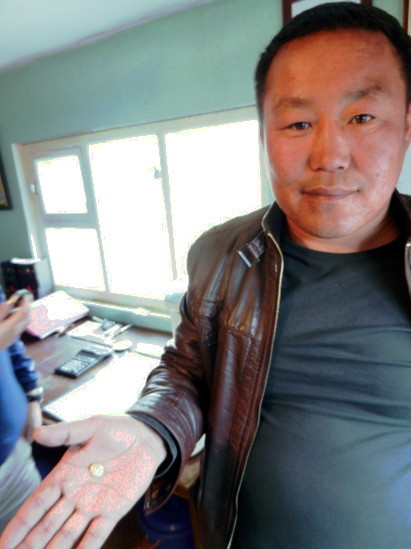I was recently in Mongolia to give a presentation on artisanal mining and conservation for the "Sustainable Artisanal Mining Project" ("SAM") funded by the Swiss and co-implemented with the Mongolian government. I spent some time with the country's thought leaders, international ASM experts, and some of the artisanal miners (the "ninjas") of Mongolia's vast plains. "I am an artisanal miner working in western Mongolia. I've mined for 10 years. In the countryside, there is no industry. We have to do ASM." – Ninja miner attending the SAM conference.
There are an estimated 100,000 artisanal miners in Mongolia; in a population of less than 3 million people, they represent 20% of the rural workforce. ASM occurs in 19 provinces in Mongolia. Artisanal miners are called "ninja miners" due to their clandestine activities (causing many to mine at night), and because they often carry their sieves or pans on their backs, which resembles the ninja turtles of the US television and comic book series. Most Mongolian ninja miners (80-90%) mine gold while the rest mine for fluorspar and coal. (Fluorspar is used as an input into manufactured products such as aluminium, gasoline, refrigerants, and steel, and can also be used in jewellery.)
Climate change, diminishing agricultural returns, dramatic economic change, and the high gold prices of the last decade (pre-2012) contributed to ASM's dramatic rise in the country. As a result, many Mongolian ninja miners are ex-farmers, herdsman, ex-factory workers, and potentially even ex-bureaucrats. Both men and women mine.
"Normally we want people moving from mining into sustainable livelihoods. Right now the opposite is happening." – International conservation leader attending the SAM Conference.
Mongolia experienced a series of droughts and hard winters between 1997 and 2002. This disseminated yak populations, forcing many herders to desperately search for alternative viable livelihoods. Yak herds serve as an income, a food source, and a form of savings for rural herders; for entire herds to die in one winter can immediately impoverish rural families. At the same time, the state was undergoing dramatic economic change. From the 1920s to the early 1990s, Mongolia was a socialist country as a result of heavy Russian influence. From 1990-1993, it transitioned from a state-run economic model to a market based economy; this resulted in a dramatic GDP drop as its industry collapsed. While agriculture, mining, and service sectors are driving new economic growth, unemployment remains at 10 per cent. The United Nations Development Programme (UNDP) notes that rural residents in Mongolia face greater challenges to secure employment because of greater distance from city centres, fewer opportunities to train and develop new skills, and generally poor market access; this has led many to turn to ASM, timbering, or wildlife hunting to augment or provide for their incomes.
Acknowledging the large rise in ASM, the Government of Mongolia passed a temporary law in 2008 to regulate the ASM sector. The 2008 law gave artisanal miners legal rights to mine but only provided limited land rights. Ninja miners grapple with harsh weather conditions, dangerous working conditions (e.g., tunnel collapses are common), and a situation where mercury has been outlawed but it is still available and in use. Making mercury illegal does not necessarily rid a country of mercury use; it merely criminalizes those who continue to use it, leading to a problem of increased mercury poisoning incidents as miners are choosing to process mercury in small enclosed spaces, such as their cars.
"You can't just stop artisanal mining. ASM will continue as long as poverty persists." – Mongolian government official, SAM conference.
Ninja miners also face social isolation; predominant beliefs in Mongolia are that the land is sacred and that mining it is a spiritual offense. As a result, public opinion is fiercely against the ninja miners, though it is gradually changing with increased understanding on who the miners are and what drove them to mine. I interviewed some gold miners in the countryside at one of the few mercury-free gold processing centres in the country. Social acceptance was a big topic of conversation. They wanted to know what I thought about artisanal mining and if I accepted them. I told them that I work with artisanal miners from around the world to help them professionalise, mine more sustainably, and improve their incomes to give people like them more options.
Some of the miners told me they were worried about what happens when they finish mining in their current ASM-designated area. They say most of the mining land in Mongolia has been given to bigger companies and there is no legal place for them to dig. With few alternatives to mining, they hinted they would be forced to become illegal again.
Natural resource depletion, water pollution, rangeland degradation, desertification, and mercury use are the main environmental concerns directly linked to artisanal miners. Reduced river levels is also being blamed on ASM; in particular the Ongiin River—a source of water for 50,000 people and 700,000 livestock—has experienced dry patches since 1999, resulting in an ecological crash and the alleged extinction of some plant species. This is likely due to the disruption of hydrological systems, water diversion, and miners' practices of melting the permafrost with wood, dung, and rubber tires in order to mine beneath it. The melting of the permafrost prevents a full spring thaw that would ordinarily replenish the river; by disrupting the permafrost, water then pours into the river via gaps of ice where it once poured through a continuous permafrost seal. As a result of these cumulative practices, the Ongiin Valley is thought to be severely impacted, leading at least one civil society movement to call for a limit on ASM to limit water extraction and for ninjas to be required to rehabilitate land.
Mercury use is a major issue in Mongolia. Despite its illegality, ninja miners are thought to use 10 tons of mercury per annum. The Boroo River is believed to be particularly impacted by mercury released by artisanal miners.
Both industrial miners and artisanal miners are also entering (or have entered) the country's protected areas in recent years. These include (or have included) The Small Gobi Strictly Protected Area (SPA), The Onon-Balji Sav National Conservation Park, Great Gobi Special Protected Area, Mon-gol Daguur Special Protected Area, and The Khan Khentii Strictly Protected Area (SPA), among many others. To date, conservationists appear reluctant to find a middle ground with miners due to the illegality of those who are mining the protected areas.
Sources:
Purevjav, Bolormaa (2011). Artisanal and Small-Scale Mining: Gender and Sustainable Livelihoods in Mongolia, Chapter 11 of Gendering the Field: Towards Sustainable Livelihoods for Mining Communities, edited by Kuntala Lahiri-Dutt. Canberra: Asia-Pacific Environment Monograph 6. Published by ANU E Press. The Australian National University. (August 2013)
Singo, Patience (n.d.). “Supporting Artisanal Miners in Mongolia: SDC's Experiences and Lessons Learnt.” Presentation for the “Sustainable Artisanal Mining Project” for the Swiss Development Cooperation Mongolia.
United Nations Development Programme (2011). Mongolia Human Development Report 2011: From Vulnerability to Sustainability: Environment and Human Development. Ulaanbaatar, Mongolia: Published by the United Nations Development Programme. (August 2013)
United States Geological Survey (2013). Minerals Information: Statistics and Information: Fluorspar. (August 2013)
World Bank (2006). “Mongolia: A Review of Environmental and Social Impacts in the Mining Sector.” An Environment and Social Development Discussion Paper. Washington, DC: World Bank's East Asia and Pacific Region. (August 2013)




